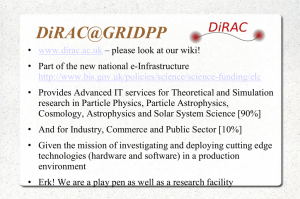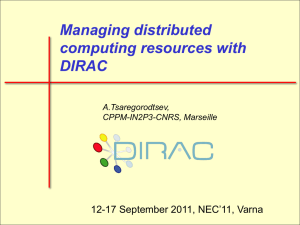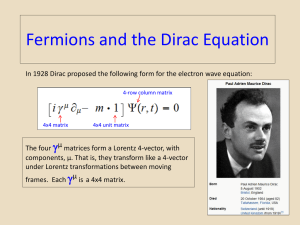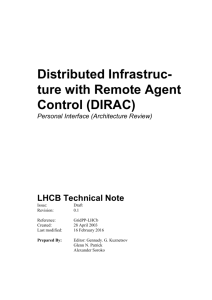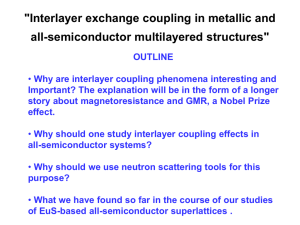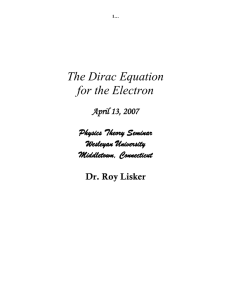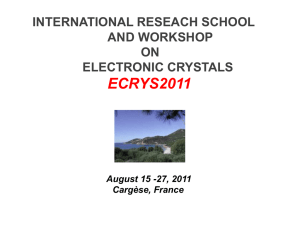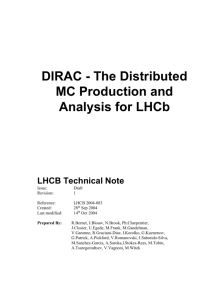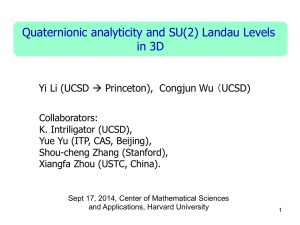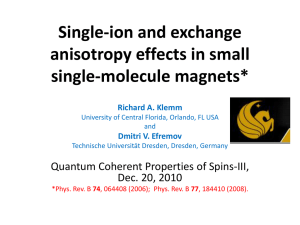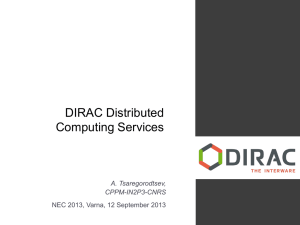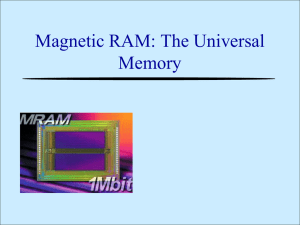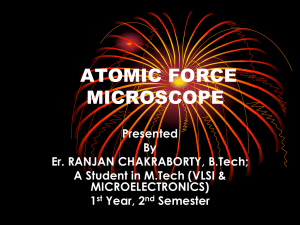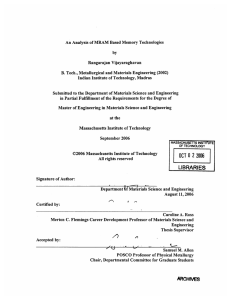Part 1
advertisement
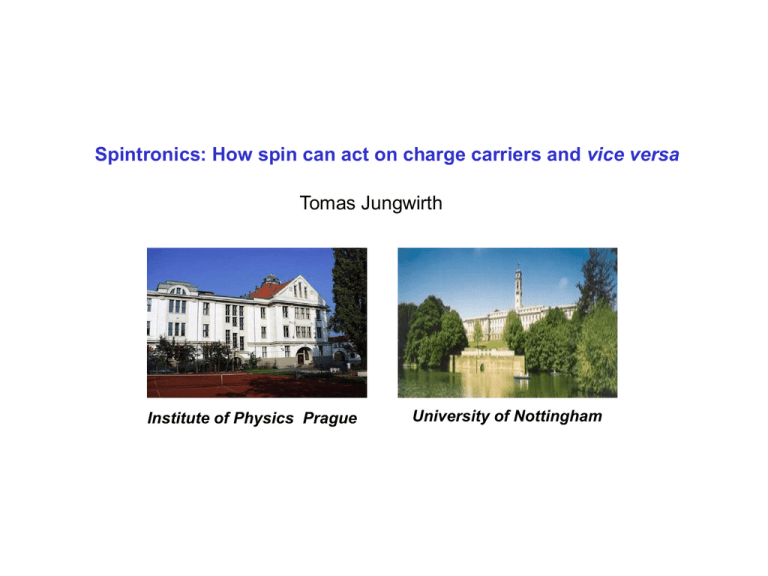
Spintronics: How spin can act on charge carriers and vice versa Tomas Jungwirth Institute of Physics Prague University of Nottingham STT-MRAM Reading by GMR (TMR) Fert, Grünberg, et al. 1988 Nobel Prize 2007 Writing by STT Sloncyewski, Berger, 1996 Buckley Prize at APS MM 2013 Read-out: non-relativistic giant magnetoresistance (GMR) Ie Ie Fert, Grünberg, et al. 1988 Nobel Prize 2007 Read-out: non-relativistic giant magnetoresistance (GMR) Fert, Grünberg, et al. 1988 Nobel Prize 2007 Antiferromagnetic arrangement of a ferromagnetic multilayer at B=0 Writing information in spin-valve: towards spintronic memory (MRAM) 1. AFM coupling between FMs at B=0 FM FM FM FM FM FM 2. One FM flips harder than the other FM Soft FM Soft FM Hard FM Hard FM 3. One FM pinned by AFM material Soft FM Soft FM Fixed FM AFM Fixed FM AFM Towards reliable switching of a particular MRAM bit Soft FM NM Fixed FM AFM Toggle switching first commercial MRAMs “Synthetic AFM“ FM FM Fixed FM AFM Writing by current: non-relativistic spin-transfer torque (STT) Spins injected from external polarizer in a non-uniform magnetic structure Mp M Ie Sloncyewski, Berger, 1996 Buckley Prize at APS MM 2013 MRAM: universal memory Write with magnetic field: on market since 2006 scales with current Write with current (STT-MRAM): on market since 2013 scales with current density MRAM: universal memory Compatible with CMOS GB MRAMs in few years Conventional architecture with CMOS New architectuture with MRAM MRAM kB MB huge gap GB TB Worldwide MRAM development Spin-transistor Datta, Das, APL 1990 Conventional architecture with CMOS New architectuture with spin-memory/logic Read-out: non-relativistic giant magnetoresistance (GMR) Ie Ie Fert, Grünberg, et al. 1988 Nobel Prize 2007 Read-out: relativistic anisotropic magnetoresistance (AMR) Spintronic effect 150 years ahead of time M Ie Kelvin, 1857 Read-out: relativistic anisotropic magnetoresistance (AMR) Spintronic effect 150 years ahead of time M Ie Kelvin, 1857 Two paradigms for spintronics “Mott“ non-relativistic two-spin-channel model of ferromagnets I I Mott, 1936 “Dirac“ relativistic spin-orbit coupling I Dirac, 1928 I Spin-orbit coupling nucleus rest frame electron rest frame I Qv 1 B 0 0 v E 2 v E c Lorentz transformation Thomas precession H SO E Q 4 0 r 3 r 0 I r B 4 r 3 g B e SB SvE 2 2 2mc Spin-orbit coupling: quantum relativistic physics p2 1 E m v2 2m 2 i (r , t ) t 2 2 ( r , t) 2m r 2 Spin-orbit coupling: quantum relativistic physics E m c2 , m m0 1 / (1 v 2 / c 2 ) Dirac equation Spin-orbit coupling: quantum relativistic physics Ultra-relativistic quantum particles (neutrino) Dirac equation E cp s spin and orbital motion coupled Ultra-relativistic quantum particles (neutrino) Dirac equation E cp s spin and orbital motion coupled Ultra-relativistic quantum particles (neutrino) Dirac equation E cp s spin and orbital motion coupled Ohmic “Dirac“ device: AMR Kelvin, 1857 Magnetization-orientation-dependent scattering Ohmic “Mott“ device: GMR Fert, Grünberg, 1988 Spin-channel-dependent scattering Tunneling “Mott“ device: TMR Julliere 1975, Moodera et al., Miyazaki & Tezuka 1995 MRAM Spin-channel-dependent tunneling DOS Tunneling “Dirac“ device: TAMR Gould, TJ et al. PRL ‘04 Magnetization-orientation-dependent tunneling DOS Magnetization-orientation-dependent chemical potential Chemical potential controlled “Dirac“ device Wunderlich, TJ et al. PRL ‘06 Dirac spintronic device without current through magnet Chemical potential of magnetic gate changes Charge on magnetic gate changes Polarisation charge on non-magnetic channel Magnet Dielectric Non-magnetic channel Ciccarelli, Ferguson, TJ et al. APL ‘12 M - + + Dirac spintronic device without current through magnet Chemical potential of magnetic gate changes Charge on magnetic gate changes Polarisation charge on non-magnetic channel Magnet Dielectric Non-magnetic channel Ciccarelli, Ferguson, TJ et al. APL ‘12 M - + + Dirac spintronic device without current through magnet Chemical potential of magnetic gate changes Charge on magnetic gate changes Polarisation charge on non-magnetic channel Magnet Dielectric Non-magnetic channel Ciccarelli, Ferguson, TJ et al. APL ‘12 M - + + + + + Dirac spintronic device without current through magnet Vg = /e Ciccarelli, Ferguson, TJ et al. APL ‘12 Direct approach to spin-transistor Inverted approach to spin-transistor Direct approach to spin-transistor Inverted approach to spin-transistor Direct approach to spin-transistor Inverted approach to spin-transistor Direct approach to spin-transistor Inverted approach to spin-transistor Direct approach to spin-transistor Inverted approach to spin-transistor

